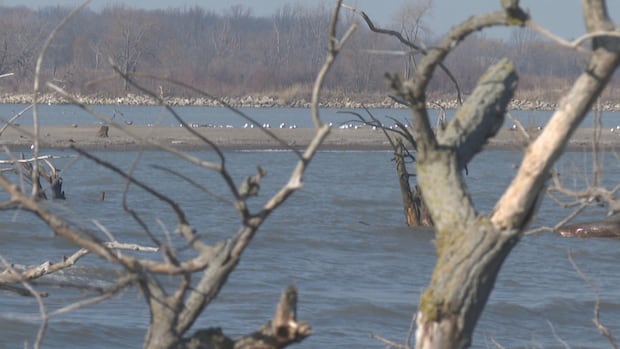[
The surface temperature in the western basin of Lake Erie is currently 26 C, and in some places, it’s more than 30 C, according to data from the U.S. National Oceanic and Atmospheric Agency (NOAA).
The average temperature for the lake on July 31 is around 24 C, according to data on NOAA’s website.
“It’s not record-breaking but certainly impressive, especially considering the cool spring we had,” said Mike McKay, the director of the University of Windsor’s Great Lakes Institute for Environmental Research.
Temperatures on the lake were 2 C below the 30-year average just three weeks ago in mid-June, McKay said, so it’s astonishing to see it heat up so quickly, especially considering how much energy it takes to raise the temperature of water.
Sustained hot weather in the region is the culprit, he added.
Windsor Morning6:29Parts of Lake Erie are already 30 C and the summer is young
We’re still early in the summer, but Lake Erie is really heating up. Mike McKay is the director at the University of Windsor’s Great Lakes Insitute for Environmental Research.
Monitoring the temperature in Lake Erie is important, McKay said, because water temperature is a contributor to the formation of blue-green algae, which can produce toxins that cause itchy, irritated eyes and skin and flu-like symptoms, such as headaches, fever, diarrhea, abdominal pain, nausea and vomiting.
“One of my colleagues published an article in … Science a few years ago called ‘Blooms Like it Hot,'” he said.
“And it’s true — cyanobacteria, blue-green algae … often prefer temperatures above 25 C.”
But temperature isn’t the only contributor to the blooms, he said.

Nutrient loads in the water are a more important factor.
“We had a relatively dry spring, which meant fewer nutrients washing into the western basin, meaning less fuel for these algal blooms,” McKay said.
A forecast released by the Oceanic and Atmospheric Agency’s National Centers for Coastal Ocean Science on May 8 predicted only mild to moderate blue-green algae blooms for 2025.
Temperatures across the lake vary considerably, McKay added.
It’s typically warmer in the western basin, cooler in the centre and quite a bit cooler in the eastern basin.
Even within those areas the temperatures fluctuate.
“As of this morning, about an hour ago, temperatures off Sturgeon Creek were 25 C and off of Hillman Marsh 24.4,” he said.
